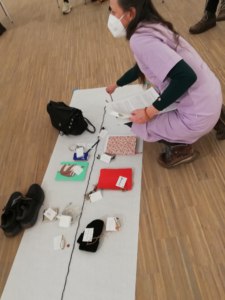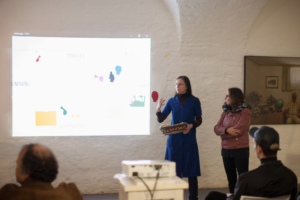A Conversation About “In The Unrest of Implication: Museum Education Methods in Atmospheres of Scandalization
Editors Note: Part of our commitment to making the Journal of Museum Education accessible is to provide free access to one article per issue, supported by our partnership with our publisher, Taylor & Francis. For the JME issue 48.3, It’s All Fake, Honestly!, our board selected the article “In the Unrest of Implication: Museum Education Methods in the Atmospheres of Scandalization,” by Karin Schneider and Andrea Hubin.
As a museum educator, I gravitate towards museums for their informal learning capabilities and meaning-making potential. In their co-authored article published in the JME’s “It’s all Fake, Honestly!” issue, educators Karin Schneider and Andrea Hubin explore how museums can be transformed as spaces for discussing complex topics through specific educational formats. In their article “In the Unrest of Implication: Museum Education Methods in Atmospheres of Scandalization,” Schneider and Hubin present examples of creative educational formats influenced by critical museum education theory and standpoint theory to help them address problematic issues such as racism and anti-Semitism in gallery and museum spaces.
I had the pleasure of speaking to Karin and Andrea about their work, their educational methods, and how they see museum institutions as spaces of great potential for these conversations to emerge and continue. In the interview below, Karin and Andrea discussed their methods to facilitate meaningful encounters and their perspectives and hopes for museums and cultural institutions.
Beatriz: You begin your article by introducing us to a quotation by Wayne Modest that museums as cultural institutions help us think through the present or have “societal conversations of what it means to live in the world with others.” As museum educators and researchers, can you expand your thoughts and discuss your museum education experience? What led you to consider or think of museum institutions as settings for these kinds of conversations and encounters? In other words, why the museum?
Karin: I liked how you framed this question because it was precisely what Andrea and I asked ourselves throughout the editing process of our text. One could argue or ask us why we are not going to schools and universities. Couldn’t we do similar work in classrooms, in social city centers, NGOs, or public spaces, and by this directly work and engage with people who pursue a political agenda; cultural places and art spaces are a hassle. After all, they are places of elite building and exclusion, as pointed out vastly in the context of new museology and critical pedagogy.
As we critically considered these questions, we realized that as museums are themselves contradictory places, full of problematic histories, such as their collections being contested as often stemming from histories of violence, they might offer themselves as environments to deal with all these issues and histories. Because of all these contradictions, museums could be good places to study them and understand ourselves as part of the problem.

Andrea: I also want to add to Karin’s explanation; on the one hand, museums have this history of violence and exclusion that Karin has pointed to, but there also exists this history of questioning the institution or of critically engaging with institutions and attempts to transform its structures of inequality or exclusion. These circles of critical investigation are histories and experiences we can build upon when visiting museum spaces. So, somehow, it could be said that we believe in the necessity to understand what alliances for certain struggles are available in the institutions. After all, museums are “curated spaces.” What does that mean?
On the one hand, this links to some kind of care and deliberation to build environments that are enjoyable to let one’s gaze wander and wonder, that are intriguing and challenging. But “curated” also means that individuals or groups have made decisions for the space, how it looks, and what objects have been chosen to unfold a narration, and this means that someone is there to take responsibility for the impact that those objects, displays, or programs will have. There is someone to be addressed with the question of why things have been done a certain way.
Karin: Going off what Andrea has said, museums organize zones between the public space, the sphere of activism if you want, and the classroom. This “inter or third space” is an interesting environment for discussions and exchange, in which the curated objects also take part and which are both open and structured. This bears the potential of a setting that allows, at the same time, reflection and engagement, being detached and involved.
Andrea: Also, what I find worth considering is that from the outside, if you look at an institution, you might think it is only one powerful voice that is talking, but this view from the outside often overlooks that there are struggles within the institution that are part of its history. There are antagonisms and conflicts of interest within the institution, allowing for possible broader alliances to form. As we can see the rise of authoritarian political developments in society, we need institutions aware of their political responsibility, with resources and voice power, to take a stand against this development.
Beatriz: I appreciate and love what you both have said about this. As a museum educator, I’ve had conversations with other educators where we expressed frustration with institutions and museums. Sometimes, we want to do away with them altogether. Still, I think you both articulated this potential amidst the tension and discomfort of having complex and difficult conversations beyond the “scandal,” as you both wrote about in your paper.
Can you talk about one of the methods you developed and worked with in different institutions? What was your experience with the “thought images” example from your article, and what advice do you have for other educators interested in implementing similar methods in educational contexts dealing with the politics of history and memory?
Andrea: The thought image, which sounds a bit like an image of a thought in English, was initially difficult to translate from the original German concept (“Denkbilder”). In German, the original term is more aligned with an image to help you think or “thinking image” with a dynamic aspect. Thinking images can take different shapes, and in the text, we only describe one example, but all “thinking images” share that something emerges in the situation and is assembled collectively at the moment by a group of people. We, for example, start by asking the participants to pull out an object from their pockets or to choose from a pool of words.
Subsequently, the group is asked to put their selected items on a table where everyone can see everyone else’s contribution. Then we stand around this assemblage, and I encourage everyone to try to understand what this might mean or what it tells us about the group, the moment, and the range of possible answers to an initial question. It’s important to note that all of us are gathered for this moment of curiosity and possibility, which we did not prepare for or know what it might mean.

Karin: Our methods trust in the group’s potential, that we can rely on the thinking and creative process of the group when we are teaching. The group creates something that comes together as this assemblage that Andrea described as “us” but also goes beyond a mere collection of individual contributions. This opens a thinking process that is bigger than what people would normally share. I think it’s crucial to develop methods that help participants be honest, think outside the box, and think critically more than share their opinions.
Andrea: With the “thinking image,” we bring one core belief to a program: objects and artworks have their agency or their voice in a way that can respond or push back against preconceived thoughts or opinions. This might sound a bit esoteric, but it makes sense in this context because when you come to a museum or gallery space with cultural objects, there are always things you won’t know; all of us will be ignorant or distant from not knowing. So, in our encounter with objects, we are all at a certain distance. Participants bring surprising new perspectives or perceptions and digging into this unknown together as a group is the venture of museum education for me.
Andrea Hubin is an art historian and educator based at the Kunsthalle Wien.
Karin Schneider is a contemporary historian and art educator. She is head of art education at the Museums of the City of Linz, Lentos Art Museum, and Nordico City Museum.
Karin Schneider and Andrea Hubin research, publish and teach art education’s history, theory, and methods. Working contexts include the project Intertwining Hi/Stories of Arts Education of the international network Another Roadmap for Arts Education and the University of Applied Arts Vienna.
They develop new methodological approaches for art education (e.g., Learning from Vulnerability, Denkbilder, Talking with Objects) and implement them in discursive projects with an experimental-performative character.

